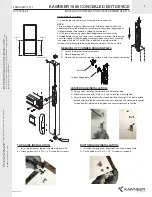
SDM-SIO1 Serial Input/Output Module
8
12
Z
‘-‘ RS-485 output line, line Z*
13
Y
‘+’ RS-485 output line, line Y*
14
B
‘-‘ RS-485 input line, line B*
15
A
‘+’ RS-485 input line, line A*
*See note above
(1)
At least one of the two G terminals (‘G’) must be connected to the loggers ground
terminal or earth boss.
CAUTION
The ground connection to the datalogger should be made
with large gauge wire, e.g. 16/0.2 to provide a low
impedance path to ground to allow full protection from
static and electrical transients.
(2)
The ‘G’ (pin 6) can be used for the RS-232 zero volt reference or any other
ground connection needed, e.g. shields.
(3)
There is a 100R resistor in series with the dataloggers ground connection. This
connection should be used when connecting RS-485 equipment by long wire
lengths. It ensures both systems have a common ground reference point. See
Section 3.2 below before connecting.
As shown above in Table 3.3 connections 1 to 5 need to be made to the datalogger,
either connecting the SDM lines to the matching control ports or the dedicated
SDM port when fitted, e.g. the CR3000. The connection of the wires to the
remote serial device will vary with type of device and method of communication.
It is necessary to work out the best mode of operation of the serial device, taking
into consideration issues such as power consumption, cable lengths (RS-485 being
better than RS-232), synchronisation of data collection etc.
In Section 3.3 there are some examples of different connection schemes for the
serial devices. Further discussion of different modes of operation are given in
Section 4.
Do not connect both RS-232 and RS-485 interfaces to the SDM-SIO1 at the
same time as this may cause a bus contention and even possibly cause damage.
3.2 Safety considerations
The SDM-SIO1 is considered to be a component of a measurement system that is
installed in an enclosure and wired up in accordance with this manual. Due to
space considerations full details of the maximum ratings of the connections are not
given on the device. Instead the user should study this manual and in particular
Section 2.1.2 to determine the maximum voltages that are applicable to any
terminal before starting an installation.
The RS-485 0V ground reference connection may be needed to ensure all units are
referenced to a common ground voltage. This is more often needed with long
cable runs.
NOTE
















































